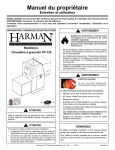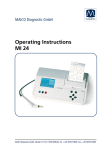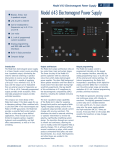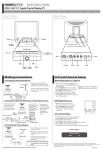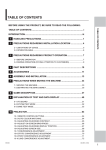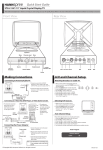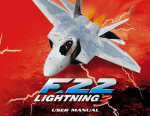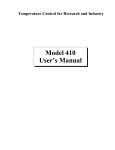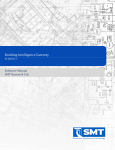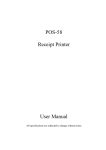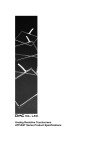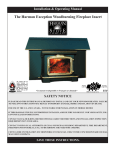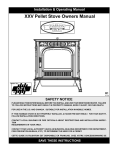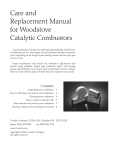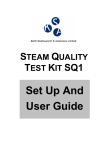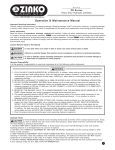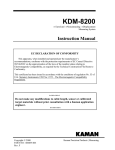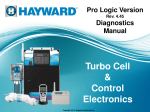Download The harman Pb 105 Pellet boiler
Transcript
Installation & Operating Manual The Harman PB 105 Pellet Boiler Portland “Ce manuel est disponible en Français sur demande” R3 SAFETY NOTICE Please read this entire manual before you install and use your new Boiler. Failure to follow instructions may result in property damage, bodily injury, or even death. FOR USE IN THE U.S. AND CANADA. SUITABLE FOR INSTALLATION IN MOBILE HOMES IF THIS HARMAN Pellet BOILER IS NOT PROPERLY INSTALLED, A HOUSE FIRE MAY RESULT. FOR YOUR SAFETY, FOLLOW INSTALLATION DIRECTIONS. CONTACT LOCAL BUILDING OR FIRE OFFICIALS ABOUT RESTRICTIONS AND INSTALLATION INSPECTION REQUIREMENTS IN YOUR AREA. Contact your local authority (such as municipal building department, fire department, fire prevention bureau, etc.) to determine the need for a permit. Cette guide d’utilisation est disponible en francais. Chez votre concessionnaire de Harman Stove Company. save these instructions Manual #3-90-07205 1-1/4” FMPT Supply Access Cover To Secondary Ash Chamber Ash Door Firebox Door Viewing Glass Hopper / Swing Plate Knob Access Cover To Control Board Cover Control Board Hopper Hopper Lid Latches PB105 Parts 1/2” FMPT Boiler Drain Combustion Blower Cover Combustion Blower Vent Pipe 1-1/4” FMPT Return (Removed w/ Domestic Hot Water Option) Blank Cover Pressure Relief Valve Aquastat Well Temperature / Pressure Gauge PB105 Parts Table of Contents Assembly 5 Venting 9 Installation 12 Operation 21 Maintenance 28 Troubleshooting 32 Feeder Parts 33 Specifications 34 Wiring Diagram 35 Parts List & Options 36 Warranty 37 Testing Label 38 Quick Reference Start-Up Back Cover Please read this entire manual before you install and use your new boiler. Failure to follow instructions may result in property damage, bodily injury, or even death. SAVE THESE INSTRUCTIONS Harman Home Heating 352 Mountain House Road Halifax, PA 17032 Outdoor Air Temperature Sensor Wiring : Assembly Assembly Boiler Kit Materials: (Refer to pages 4 & 5) List of items contained within the boiler kit shipped with the unit. 1 - Control board cover 1 - Access cover (Hopper Swing Plate Knob) 5 - Spring Handles 1 - 1/2” Boiler Drain 1 - 3/4” Safety Relief Valve 1 - 1/2” Aquastat Well 1 - 1/2” Dual Temperature/Pressure Gauge 1 - 100ft. Sensor Cable (Outdoor Air Sensor) 1 - Outdoor Air Sensor 1 - Flue Tunnel Weldment 1 - Combustion Blower Assembly 1 - Heat Shield (Comb. Blower) 2 - UY Connectors 2 - Terminals 1/4 Female 1 - #8 X 1/2” TEK 3 - 1/4-20 X 5/8” Wing Screw 4 - 1/4” Lock Washer 4 - 1/4-20 Nuts Installation of the Flue Tunnel Weldment, Combustion Blower and Wiring, ESP and Heat Shield: Step 1: First install the flue tunnel weldment by aligning the (4) studs up with the (4) holes in the ash chamber base. Fasten the (4) nuts and lock washers provided, to the studs by removing the access cover on the secondary ash chamber. Step 2: Place the combustion motor onto the flue tunnel weldment and tighten the (3) wing screws provided. Step 3: Insert the Exhaust Sensing Probe (ESP) into the 1/8” hole provided on the flue pipe stub. Fasten with the (1) #8x1/2” TEK screw also provided. ESP will be taped to the sheet metal jacket for shipping purposes. Step 4: Connect the flex conduit 90 degree elbow(Not Shown) to the heat shield in the hole provided. Then connect the (3) wires from the combustion blower with the (3) wires in the flex conduit by using the push-on connectors and matching the wire colors as follows: Red to Black, White to White and Green to Green. Step 5: Place Heat Shield over combustion blower and align the swell latches with the holes in the sheet metal and tighten. Flue Tunnel Weldment ESP Probe Combustion Blower Heat Shield NOTE: Refer to Fig’s 22, 23 and 24 located in the maintenance section of this manual. Assembly After assembly of the flue tunnel weldment, combustion blower assembly with wiring and heat shield, the boiler can now be installed. 1. Install the control board cover as well as the access cover located on the feeder cover. 2. Install the spring handles provided with the unit on the ash door, firebox door and the heat exchanger cleanout rod handles. (Fasten handles by turning them counterclockwise and pushing inward simultaneously). 3. Install 1/2” MPT boiler drain in the fitting as shown. Note: Use teflon pipe thread sealant or teflon tape on ALL threads before connections are made. 4. Install 3/4” MPT pressure relief valve as shown. 5. Install the 1/2” MPT aquastat well in fitting as shown, then place aquastat in the well and fasten with a zip tie. 6. Install the 1/2” MPT temperature/pressure gauge in fitting as shown. 7. Locate and install outside air temperature sensor. Location of this sensor should be on the north side of the home or building and out of direct sunlight. Use the cat cable supplied with the boiler to attach sensor to the terminals located on the hopper. (Place at the back side just above and to the right of the main power connection box) The wires can be connected to the sensor with the connectors supplied. Wire nut or butt splice connectors could also be used. The connections at the boiler can be done with the two 1/4” female push on connectors supplied. 8. Fasten conduit to the ash base with the clamps provided. MINIMUM NON-COMBUSTIBLE FLOOR PROTECTION AREA Design: The first thing that needs to be done is deciding where and how the boiler will be installed. Things that need to be taken into consideration are the intended use of the boiler for example, is the boiler going to be used as your primary heating system or is it going to be used as a secondary or backup heating system. If it is to be used in conjunction with an existing oil or gas boiler system will it be piped in parallel or in series? The answers to these and other questions can be determined by talking to your certified dealer or a qualified HVAC or plumbing contractor. This will insure that the boiler is installed and piped to accommodate your needs and expectations. Floor Protection: The striped area indicates the minimum required floor protection area if the PB105 is going to be placed on a combustible floor. It requires 30” X 55” of non combustible floor protection as shown below. 6” of the floor protection must be in front of the boiler as shown. Flooring must be a minimum of 26 gauge sheet metal. Floor protection must also be provided under any Consideration must be given to the venting as well as electrihorizontal run of vent pipe equal to the outside diameter of cal and clearance requirements. (Clearances must be mainthe venting plus 2” to each side. tained to combustibles and also for service) Example: 4” type “L” or “PL” vent pipe has an outside di- After the boiler is set into place the venting can be done. ameter of 4-1/2” + 2” on each side equals a protected floor area of 8-1/2” wide underneath the horizontal run. Make sure fans are not used in the fuel storage area, unless they are installed so as not to create a negative pressures in the room where the solid fuel burning appliance is located. Assembly When installing the PB105 in a mobile home several requirements must be followed: 1. The unit must be bolted to the floor. 2. The unit must be connected to outside air. 3. Floor protection and clearances must be followed. 4. Unit must be grounded to the metal frame of the mobile home. INSTALLATION IS TO BE PERFORMED BY A QUALIFIED INSTALLER. NOTE: All installation clearances and restrictions must be adhered to. NOTE:Use only 4” diameter type “L” or “PL” venting system. Be sure to inspect and clean exhaust venting system frequently. Venting Requirements for Terminating the Venting WARNING: Venting terminals must not be recessed into a wall or siding. NOTE: Only PL vent pipe wall pass-throughs and fire stops should be used when venting through combustible materials. NOTE: Always take into consideration the effect the prevailing wind direction or other wind currents will cause with flyash and /or smoke when placing the termination. In addition, the following must be observed: A. The clearance above grade must be a minimum of 18”.1 B. The clearance to a window or door that may be opened must be a minimum of 48” to the side, 48” below the window/door, and 12” above the window/ door.1 ( with outside air installed, 18” ) C. A 12” clearance to a permanently closed window is recommended to prevent condensation on the window. D. The vertical clearance to a ventilated soffit located above the terminal within a horizontal distance of 2 feet (60 cm) from the center-line of the terminal must be a minimum of 18”. E. The clearance to an unventilated soffit must be a minimum of 12”. F. The clearance to an outside corner is 11” from center of pipe. G. The clearance to an inside corner is 12”. = Vent terminal = Air supply inlet H. A vent must not be installed within 3 feet (90 cm) above a gas meter/regulator assembly when measured from the horizontal center-line of the regulator.1 I. The clearance to service regulator vent outlet must be a minimum of 6 feet.1 J. The clearance to a non-mechanical air supply inlet to the building or the combustion air inlet to any other appliance must be a minimum of 48”.1 K. The clearance to a mechanical air supply inlet must be a minimum of 10 feet.1 (with outside air installed, 6 feet ) L. The clearance above a paved sidewalk or a paved driveway located on public property must be a minimum of 7 feet.1,2 M. The clearance under a veranda, porch, deck or balcony must be a minimum of 12 inches.1,3 NOTE: The clearance to vegetation and other exterior combustibles such as mulch is 36” as measured from the center of the outlet or cap. This 36” radius continues to grade or a minimum of 7 feet below the outlet. 1 Certain Canadian and or Local codes or regulations may require different clearances. 2 A vent shall not terminate directly above a sidewalk or paved driveway which is located between two single family dwellings and serves both dwellings. 3 Only permitted if veranda, porch, deck, or balcony is fully open on a minimum of 2 sides beneath the floor. NOTE: Where passage through a wall, or partition of combustible construction is desired, the installation shall conform to CAN/CSA-B365. (if in Canada) = Area where terminal is not permitted Fig. 2 Fig. 3 Venting 10 Venting Venting Venting Use 4” pellet vent pipe to vent your PB105. A combustion blower is used to extract the combustion gases from the firebox. This creates a negative pressure in the firebox and a positive pressure in the venting system as shown in Fig. 4. The longer the vent pipe and more elbows used in the system, the greater the flow resistance. Because of these facts we recommend using as few elbows as possible and 30 feet or less of vent pipe. The maximum horizontal run should not exceed 18 feet. Be sure to use wall and ceiling pass through fittings (which are approved for pellet vent pipe ) when going through combustible materials. Be sure to use a starting collar to attach the venting system to the stove. The starting collar must be sealed to the stove flue collar with high temp silicone caulking or aluminum tape, and screwed into the stove flue collar at least three (3) places. + - Fig. 4 Vent Pipe 4” pellet vent pipe (also known as “L or PL” vent) is constructed of two layers with air space between the layers. This air space acts as an insulator and reduces the outside surface temperature to allow a minimum clearance to combustibles of 1 inch. In Canada the minimum clearance to combustibles is 3 inches. The sections of pipe lock together to form an air tight seal in most cases; however, in some cases a perfect seal is not achieved. For this reason and the fact that the PB105 operates with a positive vent pressure, we specify that all joints within the structure should also be sealed with clear silicone. NOTE:Use only 4” diameter type “L” or “PL” venting system. Be sure to inspect and clean exhaust venting system frequently. 4” Type “L” or “PL” Vent pipe Fig. 5 This is the minimum venting configuration. The minimum vent configuration is a 90o or Tee on a starter collar and a 24” length horizontal through an exterior wall. A cap on the end should direct the flue gasses down and away from the structure. See Fig. 5. The maximum horizontal length is 18 feet. The minimum termination height above the exterior grade is 18”. The maximum total length of any configuration is 30 feet*. * ( see venting graph on page 10 for exceptions ) NOTE: Cleanout Tee’s should always be used on the transitions to horizontal pipe to allow easy access for cleaning. The venting graph allows for one(1) 90 deg. or Tee fitting in any configuration. If more 90’s, T’s, or 45’s are needed the total length must be adjusted to allow for the added restriction. Up to four (4) additional 90’s, Tee’s, or equivalent 45’s can be added as long as the overall length is adjusted in accordance with the values listed below. ( See the venting graph on page 10.) Each Vertical ---- 90 deg. or T subtract 2.5 feet Each Vertical ---- 45 deg. subtract 1.5 feet Each Horizontal - 90 deg. or T subtract 5.0 feet Each Horizontal - 45 deg. subtract 2.5 feet Any exterior venting (vent pipe exposed to outside ambiant temperatures) should be kept to a minimum, due to potential condensation problems. This is especially important in high humidity cold weather climates, such as maritime areas, lake shores, and low river valleys. 11 Venting Installation NOTE: Use only 4” diameter type “L” or “PL” venting system. Be sure to inspect and clean exhaust venting system frequently. INSTALLATION IS TO BE PERFORMED BY A QUALIFIED INSTALLER. DO NOT INSTALL A FLUE DAMPER IN THE EXHAUST VENTING SYSTEM OF THIS UNIT. DO NOT CONNECT THIS UNIT TO A CHIMNEY FLUE SERVING ANOTHER APPLIANCE. Chimneys taller than 20’ above the connection will require a draft test to determine if the draft is too high. Note: The High Burn Draft should not exceed .85 IWC. Some form of a restrictor plate may be required at the top of high chimneys to reduce the draft. See page 20 for the Draft Test procedure. The PB105 Boiler may be used and installed into an existing masonary or Class A metal chimney. Certain Canadian and Local Codes may require that the chimney be fully relined. The venting Can Not be installed in a chimney serving another appliance. The chimney should be cleaned and or inspected before installation of the venting. INSTALL VENT WALL PASS-THROUGHS AT CLEARANCES SPECIFIED BY THE VENT MANUFACTURER NOTE: All installation clearances and restrictions must be adhered to. NOTE: Read and follow all of the vent pipe manufacturers’ instructions on the proper installation and support of the vent pipe. Adhere to all clearances. WARNING Keep combustible materials such as grass, leaves, etc. at least 3 feet away from the point directly under the vent termination. (between the vent and the ground) WARNING MOBILE HOME GUIDELINES DO NOT ALLOW INSTALLATION IN ANY ROOM DESIGNATED FOR SLEEPING. CAUTION Other examples of possible installations of the venting. Keep combustibles away from flue outlet. Creosote - Formation and Need for Removal - When wood is burned slowly, it produces tar and other organic vapors, which combine with expelled moisture to form creosote. The creosote vapors condense in the relatively cool chimney flue of a slow-burning fire. As a result, creosote residue accumulates on the flue lining. When ignited, this creosote makes an extremely hot fire. The pellet vent pipe should be inspected at least twice monthly during the heating season to determine if a creosote buildup has occurred. If creosote has accumulated it should be removed to reduce the risk of a chimney fire. Guidance on minimizing creosote formation and the need for periodic creosote removal: The chimney should be inspected during the heating season to determine if a creosote build-up has occurred. If a significant layer of creosote has accumulated (3mm or more) it should be removed to reduce the risk of a chimney fire. 12 Installation Outside Air Inlet Cover part# 1-10-09542 Fig. 6 Outside Air Pipe Knockout Feeder Cover Fig. 7 Outside Air Inlet Pipe Outside air is optional, although it may be required by some building codes. The benefit of outside air is higher efficiency and reduced venting restrictions. To install outside air, use 2 3/4” I.D.galvanized steel flex pipe, part # 2-00-08544 ( 12’ 6” length) or part # 2-00-08545 ( 25’ length) See Fig. 6. There is a break-away hole on the rear panel which must be removed before connecting the flex pipe. See Fig. 7. The pipe should be run outside and terminate 3 feet or more below or 1 foot or more to the side of the vent pipe outlet. Never terminate the outside air above the vent pipe outlet. The maximum length of this pipe is 20 feet. Inlet cover part number 1-1009542 should be used to keep birds, rodents etc.out of the inlet pipe. See Fig.6. NOTE: If outside air is installed, the inlet cover should not be placed in an area where drifting of snow or ice will build up, blocking the intake air supply. The Outside Air knockout is located on the face of the Feeder Cover. It is pre-cut except for several small tabs. There is also a filler plate screwed to the inside to cover the top of the hole after the Outside Air Pipe has been installed. This will allow for removal of the Feeder Cover without disconnecting the Outside Air Pipe. See Fig. 7. Only metal Intake Flex should be used for the Outside Air Supply connection. The Outside Air Intake Pipe is inside the Feeder Cover and to the right of the feeder motor. The 2 3/4” steel flex pipe is made to slide over the outside of the Air Intake Pipe. See Fig. 8. It should be held into place with some silicone, foil tape, or a hose clamp. (not supplied) Heat Reclaiming Ventilation System (HRV) When installing in a house with a Heat Reclaiming Ventilation System (HRV) be sure the system is balanced and is not creating a negative pressure in the house. Hopper/Feeder Swing Plate Knob NOTE: If the boiler is installed with the outside air system no adjustments to the HRV should be necessary. Fig. 8 13 This boiler should never be powered by the use of an extension cord. The recommended high and low voltages are, 130 V.A.C. 60 Hz maximum high voltage, and 113 V.A.C. 60 Hz minimum low voltage.The furnace will continue to operate at voltages as low as 105 V.A.C. , although it can not be guaranteed that automatic ignition will occur. NOTE: If other sources of electrical power are to be used ( such as a generator ) for normal operation or emergency operation, this source should be checked before installation. Many generators and inverters may not supply 120V.A.C. 60Hz. power stable enough to operate the control board properly. (Control board damage could occur). To install power to the boiler, first remove the cover on the 4” X 4” junction box located on the back of the unit. There are several knockout holes provided for the incoming main power wires. Also, a knockout hole can be used for the auxiliary output overheat zone (if used). The minimum recommended circuit is 6 AMP - 120 VAC - 60 HZ. This boiler should be the only appliance on the circuit. If a 15 AMP circuit breaker is used at the distribution box, the boiler must be protected with an in-line fuse rated at 6 AMP. Main Wiring Installation 14 Installing Duct Installation 15 Installing Duct/Air Conditioning Installation Boilers intended to be connected to an existing boiler or boiler system shall: 1. Be capable of being installed without interfering with the normal delivery of heated water from the original boiler to the radiation system. 2. Be capable of being installed to operate as intended without affecting the operation of the electrical and mechanical safety controls of the original boiler. 3. Provide, upon completion of the installation, for a change over from one fuel to the other without requiring the manual adjustment of any controls or components other than the thermostats. 4. Be compatible with the operation of a service water-heating coil within the original boiler without bypassing the operation of the solid-fuel boiler. 5. Have provision for preventing, or adequate water capacity within the boiler to prevent, damage to the boiler from loss of circulation due to electrical power failure. 6. Be capable of being installed without changing the function of the control or rewiring of the original boiler. A wiring interconnection is permitted. The electrical system of both boilers shall be powered from a single branch circuit without exception. (CAN/CSA-B366.1-M91) 16 Installation A 17 Installation 18 Installation 19 Installation Firebox Door Draft Bolt Location Air Wash Slot Air wash Slot Viewing Window Fig. 9 “Test” Draft Test Procedure After the venting is completed, the firebox low draft will need to be checked and possibly adjusted. After removing the 3/8” bolt from the draft hole shown in Fig. 9, insert the draft meter tube. The hopper lid must be latched during this test. (It is recommended that the draft meter have a scale of 0 to 1” WC.) Turn the feed adjuster to “Test”. this will start the combustion blower and allow you to check and record the High Draft ______ - IWC date _______ (There is no adjustment for the High Draft) After the first 60 seconds the “Test” mode lowers the combustion blower voltage to the Low Burn voltage. (The “Test” mode cycles the voltage from high to low every 60 seconds).During this lowered voltage cycle the Low Burn Draft must be checked and adjusted if necessary. The recommended low draft setting should be between -.25 & -.35 IWC. Depending on the amount of vertical rise, it may not be possible to get a low draft reading in this range. In this case, a maximum low draft of -.55 is acceptable. The adjustment screw is through the small hole to the right of the Igniter Light. See Fig. 10. Adjusted Low Draft is __________ -IWC. Don’t forget to turn the feed adjuster back to #4. The Control Low Draft Adjustment Pot Fig. 10 Covered Un-Covered The PB105 has the option to have the control panel covered or un-covered See Fig. 11. There is a pair of slots provided for each position. Simply move the cover to the desired position by placing the tabs on the cover in the proper slots. CAUTION: Hot while in operation. Do not touch. Keep children, clothing, furniture, and other combustible material out of the installation clearance area. WARNING: Do not operate with fire chamber or ash removal doors open. WARNING: Do not store fuel or other combustible material within installation clearance area. Fig. 11 20 Operation Power Light Indicates power to the control board. Feed adjuster Sets the maximum feed rate Status Light Will be lit anytime there is a call for heat. Test Combustion blower, feed motor and safety dump zone are fully energized for the first minute. Combustion blower alternates from high to low every minute. Overheat Saftey Zone Light Indicates that the boiler water temperature has reached 210 Degree F. Lighting Mode Selector Switched between Auto and Manual lighting Mode Selector/Min Temp Dial Used to turn the boiler on or off and set the desired minimum operating temperautre of the boiler. Combustion Blower Light Indicates Power to combustion blower Feed Motor Light Indicates Power to the feed motor. Dealer Diagnostic Port For dealer maintenance only. Requires special DDM monitor supplied to Harman Dealers exclusively. Igniter Light Indicates power to the igniter Max Temp dial The “Max Temp Dial” is used to set the desired maximum operating temperature of the boiler. Status light error messages: 1 Blink: Indicates control board self diagnostic failure. This requires a manual reset by cycling the main power off for a few seconds and re-connect. 3 Blinks: Indicates ESP (Exhaust Sensing Probe) failure. This requires a manual reset by cycling the main power off for a few seconds and re-connect. 4 Blinks: Indicates an aquastat failure, or the aquastat is not attached properly. May require a manual reset. Note that in some optional control methods, this status will occur during normal operation and reset automatically. 5 Blinks: (In Auto Light Mode Only) Indicates that the igniter has failed to light the fire after 40 Minutes. To reset - Turn the Mode Selector/Min. Temp. to OFF and then back to the desired temperature. 6 Blinks : Indicates that the control has calculated poor or incomplete combustion occurring for 25 or more minutes. A six blink status may be set if the stove is allowed to run out of pellets. To reset, turn Mode Selector/Min Temp dial to “OFF” then back on to the desired temperature. If the unit was not out of pellets, see Troubleshooting section, Page 32, for more details. 7 Blink: Boiler water over heat saftey shut down (220 Degree Farenheit) This requires a manual reset by cycling the main power off for a few seconds and re-connect. Mode Selector/Min. Temp. Used to turn the boiler on or off and set the desired minimum operating temperautre of the boiler. Max. Temp./ Min. Temp. Water Temperature Settings See “Setting the boiler temperature” found on page 22. OFF Mode Turning the Mode Selector/Min.Temp. to OFF will shut down 21 the boiler. Operation Setting The Boiler Temperature Without the Outdoor Air Temperature Sensor Installed To set the maximum boiler water temperature, simply turn the Max. Temp. water temperature dial to the desired setting. The control and the boiler will then perform to achieve and maintain the set temperature. The Min. Temp. Knob simply becomes the boiler mode switch, on or off. Turning the knob fully counterclockwise is the “OFF” position while turning the knob clockwise past the 140 degree position is the “ON” position. WATER TEMPERATURE MAX. TEMP. Control Board Operation MIN. TEMP. Aquastat Sensor - This sensor is located in the aquastat well on the top of the water jacket. This sensor along with the outdoor air sensor is what the control board uses to regulate the feed rate based on these two observed conditions. (Boiler Temp. & Outdoor Air Temperature) Outdoor Air Temp. Sensor (OAT) - This sensor is located outside the building (on the north side of the house and out of direct sunlight). The Outdoor Air Sensor is used to perform hot water reset based on outdoor air temperatures. When the OAT sensor is installed, at 20° F. or below (outside temperature), the boiler will operate at the temperature set on the MAX. TEMP. knob. The boiler water temperature will decrease by 1 degree F. for every 1 degree F. in temperature rise (above 20°) of the outdoor air. NOTE: Pellet Boiler Outdoor Air Reset Operation Graph located on page 23. 22 With The Outdoor Air Temp - Sensor Installed Maximum boiler temp setting is as described above. The MIN. TEMP. knob in addition to being the mode setting (on or off) now also has the function of setting the minimum boiler water temperature. This would be the lowest boiler water temperature that you want to have based on the following factors. 1.) Outdoor Air Temperature (OAT) 2.) Domestic Hot Water Use a.) Hot Water Coil Option b.) Indirect Hot Water Storage 3.) Overall Volume of the Heating System The PB105 is designed to withstand lower return water temperatures however, extended return temperatures below 140 degrees F can cause condensation in the secondary ash chamber area and also in the venting system, both of which could cause damage in these areas. NOTE: If the system is run at the lower temperature settings, conditions of the firebox, boiler tubes, secondary ash chamber and venting should be monitored closely. If any indications show excess condensation the boiler water temperature will need to be increased until condensation does not occur. OAT 65o 60o 55o 50o 45o 40o 35o 30o 25o 20o 15o 10o 5o 0o Example 2 Max set at 180o Min set at 150o Water Temp 150o 150o 150o 150o 155o 160o 165o 170o 175o 180o 180o 180o 180o 180o Water Temp 140o 145o 150o 155o 160o 165o 170o 175o 180o 185o 185o 185o 185o 185o Degree Change * * * -30o -25o -20o -15o -10o -5o 0o 0o 0o 0o 0o Degree Change -45° -40° -35° -30° -25o -20o -15o -10o -5o 0o 0o 0o 0° * No change in boiler temperature after reaching minimum setpoint temperature. OAT 65o 60o 55o 50o 45o 40o 35o 30o 25o 20o 15o 10o 5o 0o Example 1 Max set at 185o Min set at 140o When the outdoor sensor is installed, at 20° F. or below OAT (Outdoor Air Temperature), the boiler will operate at the temperature set on the Maximum Temperature knob. The boiler water temperature will decrease by 1 degree for every 1 degree in temperature rise of the Outside Air. Pellet Boiler Outdoor Air Reset Operation Operation 23 Operation Starting A Fire Automatically 1. Turn Mode Selector to “OFF”. This resets the control in addition to turning it off. 2. Clean Burnpot with scraper, if necessary. This is usually a weekly maintenance procedure. Cleaning the burn pot with the scraper with a small amount of new fuel in the bottom is not a problem. First, scrape the ashes on the front of the burn pot into the ash pan. Then scrape the hole grid surface downward into the burn pot. When the stove is ignited these scrapings will be pushed out by the feeder. Scrape burnpot to remove any carbon build-up that may have occurred NOTE: To minimize the amount of stress placed on the hopper swing plate hinges, opening of the hopper swing plate should be done with the least amount of fuel in the hopper as possible. Scraping can be done while in operation 3. Fill Hopper with pellets. When filling the hopper check for excessive fines in the bottom of the hopper. Fines are small pieces of broken pellets (sawdust). Fines do not flow easily and often build up on the hopper funnel bottom angles. These fines can be pushed into the feeder opening and then fill the hopper with pellets. As the system works, they will be burned. 24 Operation 4. If Starting After an Empty Hopper, Turn Feed Adjuster to “TEST” (for one 60 second cycle). This will purge pellets into the auger tube and also allow you to check the motors for operation. NOTE: The auger motor will not operate with any of the doors open. 5. Turn Feed Adjuster to #4. If this is your first fire or you are trying different pellets, set the feed adjuster to #4, This is a conservative number and will probably need to be increased if maximum BTU output is desired. After you know a feed rate setting that works well for your application, use that setting. NOTE: You know your feed rate is too high when: The overheat safety feature is energized each time the heating zone demand turns off during a high burn. OR, If unburned or partially burned pellets are found in the ash pan. 6. Flip the Igniter Switch up into the “AUTO” position. WATER TEMPERATURE MAX. TEMP. MIN. TEMP. 7. Turn the MAX. TEMP. Dial on the control board to the desired temperature. This setting must always be at least 5° F. higher than the MIN. TEMP. setting. WARNING: HOT WHILE IN OPERATION. KEEP CHILDREN, CLOTHING, AND FURNITURE AWAY. CONTACT MAY CAUSE SKIN BURNS. 25 Operation Fig. 12 7. Open hopper swing plate as shown in Fig. 13 (See “NOTE” on page 24.) 8. Turn the MIN. TEMP. Dial on the control board to the desired Minimum temperature. This will start the lighting process if the temperature at the aquastat sensor is approximately 5° F. less than the set temperature on the MAX TEMP. dial. The PB105 is more than just an automatic ignition pellet boiler. The automatic system will allow the fire size to be adjusted to match the heating needs and even put the fire out if necessary. If heat is needed after the fire is out, the PB105 will automatically re-ignite and adjust the fire size to match the heating need. 9. Fill hopper with pellets and remove ashes as required. Type of Fuel Use pelletized wood only. The lower the ash content of the pellets the less cleaning that will be needed of the heat exchanger surfaces. The cleaner these surfaces are kept, the more efficient the boiler will be. NOTE: Do not burn garbage, gasoline, naphtha, engine oil, or other inappropriate materials in the PB105. Store pellets in the manufacturer’s wrapping until needed to prevent pellets from absorbing moisture. Do not store fuel within the appliance installation clearances, or within the space required for fueling, ash removal, and other routine maintenance operations. Lighting A Fire Manually Lighting the fire manually will not be necessary unless the igniter in the burnpot fails. Follow steps 1 through 5 of the instructions for automatic lighting. 6. Flip the Igniter Switch Down into the “MANUALLIGHT” position. See Fig. 12. 26 Fig. 13 8. Fill burnpot with pellets as shown. See Fig. 14. Only fill level with the front edge. ( ------- DO NOT OVERFILL ------- ) Fig. 14 9. Have matches or other ignition source ready. 10. Turn Mode Selector to desired MIN TEMP setting. This will start the combustion blower and allow the ESP to control the fire in relation to the MAX TEMP Dial setting. (The MAX TEMP dial setting must always be set above the MIN TEMP setting) Once the fire is well established the MAX TEMP dial can remain on any temperature setting desired. NOTE: When the Switch is set to Manual igniter position the boiler will function as in auto igniter except the fire will not be allowed to go out. It will only be allowed to go to a minimum burn rate between the times the aquastat is calling for heat. This rate is about 1.1 pound of fuel per hour. Operation 11. Apply starting gel as shown in Fig.15 Fig. 15 NOTE: Stirring the starting gel into the pellets usually allows the fire to become established quicker. CAUTION: A vapor flash could occur if too much time is allowed to pass before lighting the starting gel. CAUTION: Care must be taken not to get starting gel on your hands or clothing. Serious burns could occur during the lighting process. CAUTION: Never try to apply more starting gel to an already burning fire, or a fire with smoldering pellets. “NEVER USE GASOLINE, GASOLINE-TYPE LANTERN FUEL, KEROSENE, CHARCOAL LIGHTER FLUID, OR SIMILAR LIQUIDS TO START OR “FRESHEN UP “ A FIRE IN THIS FURNACE. KEEP ALL SUCH LIQUIDS WELL AWAY FROM THE FURNACE WHILE IN USE”. 12. Light The Starting Gel With A Match. 13. Close The Doors The fire will light and the PB105 will adjust the fire to proper level according to the MAX TEMP dial setting. Solid-fuel burning appliances need to be cleaned frequently because soot, creosote, and ash may accumulate. If you suspect a chimney/vent pipe fire do the following: 1. Call the fire department. 2. Remove fuel from the burn pot using the burnpot scraping tool to scrape the pellets into the ash pan. 3. Remove the ash pan from the unit and take outside. Do not place ash pan on a combustible material. 4. Turn off circuit breaker at unit. 5. Do not use the unit until a qualified person has inspected your appliance and venting. Fig. 16 27 Maintenance Burnpot Cleaning: The burnpot should be cleaned no less than once a week. For best operation the burnpot should be cleaned every time the hopper is filled with pellets. The fire does not have to be out to scrape the burnpot although it is recomended the boiler be on minimum burn at the time of cleaning. Note: Scraping can be done while in operation if performed through the firebox door opening. See Fig. 17 Scrape the burnpot to remove any carbon Scrape burnpot to remove any carbon deposits which may have formed. build-up that may have occurred Scraping can be done while the boiler Scraping can be done while in operation is in operation, accessed through the firebox door opening. Fig. 17 Use the flat end of the scraper provided to scrape down over the holed surface of the burnpot grate. See Fig. 18. It is not necessary to clean out the scrapings from this cleaning because they will be pushed out the next time the auger operates. Note: Make a special effort to scrape the bottom inside corners of the burnpot where the auger tube enters the burnpot. Carbon deposits can build up over time in this area that may cause a restriction to the flow of pellets into the burnpot. Note: An old long shank screwdriver with the end sharpened is an ideal aid in the removal of these deposits. Fig. 18 Fines cleanout cover Fig. 19 Fines area Feeder cover 28 Fig. 20 Cleaning the Burnpot Air Chamber: This area only needs to be cleaned twice a heating season, unless excessive buildup is noticed during scheduled cleanings. There is a cover on the front of the burnpot to gain access to the air chamber and igniter. The cover is held into place by two thumb screws. Loosen the thumb screws and remove the cover. See Fig. 19. The air chamber can be cleaned of any ash that has fallen through the holes during operation and cleaning. Also at this time, remove the feeder assembly cover and remove any fines that may have accumulated. NOTE: ALWAYS REMEMBER TO CLOSE THE CLEANOUT COVER AFTER CLEANING. Feeder Chamber (Fig. 20): This chamber may get a buildup of fines from the feeder mechanism movement. This area should be checked and cleaned at least once a year. To remove the feeder cover: • Loosen the 5/16” wing nut. • Slide the cover off of the threaded stud and lift upward. • Inspect and clean the inner chamber if necessary. See Fig. 20. • Reinstall the cover making certain it is centered on the feeder body and hand-tighten the wing nut. Maintenance Ash Pan Handle Ash Door Ash Door Handle Ash Pan Fig. 21 Ash Removal It is recommended to remove the ashes when the boiler is not in operation. This lessens the chances of coming in contact with hot surfaces. Ashes can be removed while in operation but, extra care must be taken. Open Ash Door Lift the latch and open the door as shown in fig. 21. Disposal of Ashes Ashes should be placed in a metal container with a tight fitting lid. The closed container of ashes should be placed on a non-combustible floor or on the ground, well away from all combustible materials, pending final disposal. If ashes are disposed of by burial in soil or otherwise locally dispersed, they should be retained in the closed container until all cinders have thoroughly cooled. NOTE: Keep hopper lid, hopper swing plate, firebox Soot and Flyash: Formation and Need for door and ash pan door closed during operation and Removal maintain all seals in good condition. The products of combustion will contain small particles of flyash. The flyash will collect in the exhaust Remove Ash Pan venting system and restrict the flow of the flue gases. Always wear gloves to remove ash pan. Grab the Incomplete combustion, such as occurs during startup, ash pan by the finger hold and pull it out of the boiler. shutdown, or incorrect operation of the room heater Lift the ash pan by the finger hold and use it for carrywill lead to some soot formation which will collect in ing the ash pan. Close the ash door before disposing the exhaust venting system. The exhaust venting system the ashes should be inspected at least twice monthly to determine if cleaning is necessary. 29 Maintenance Heat Exchanger Cleanout Rod Handles Firebox Door Heat Exchanger Tube Secondary Ash Chamber Access Plate Fines Cleanout Cover Firebox Wall Cleaning This cleaning should be done after each ton of pellets used. The frequency of this cleaning will be directly related to the quality and the ash content of the pellets being used. Keep in mind that the cleaner the heat exchanger surface is kept, the higher the heat transfer efficiency will be. Due to it’s ease of restarting it is recommended that the boiler be OFF and COOL before cleaning. Start by pulling the (3) heat exchanger cleanout rods by pulling and pushing these rods vigorously severl times. It will remove any fly ash built up on the heat exchanger tubes. This can also be done at any time during the operation of the boiler to maintain higher efficiencies. Make sure that these rods are pushed in at all times. Cleaning Steps -Open hopper swing plate to access burnpot and also the firebox. With a wisp brush, wire brush, stiff bristled paint brush or a soot vac, clean the firebox walls and any fly ash that has accumilated on the ledges of the burnpot, or burnpot opening. At this time you can scrape and clean the burnpot and fines cleanout area. Be careful not to damage the igniter located inside the burnpot. -Open firebox door and vaccum ash from ledges and ash deflector. You can also clean the firebox door viewing glass using a typical glass cleaner and soft cloth. 30 Ash Door -Open ash door and remove the ash pan. Dispose of any ash that has accumilated in the ash pan as well as any fly ash from within the ash pan area. -Remove the (4) thumbscrews on the secondary ash chamber access plate and remove it to access the secondary ash chamber. Remove all fly ash from this area. This process should be done as needed. -Inspect all sealing gaskets to insure a proper seal and re-install all components removed for cleaning. CAUTION: Cleanout of the heat exchanger, flue pipe, chimney, and combustion blower fan housing, is especially important at the end of the heating season to minimize corrosion during the summer months, caused by accumulated ash. NOTE: To minimize the amount of stress placed on the hopper swing plate hinges, opening of the hopper swing plate should be done with the least amount of fuel in hopper as possible. Maintenance Heat Shield Latch Fig. 22 ESP Probe Combustion Blower Motor Thumb Screws (3 Total) Fig. 23 Sealing Overlap NOTE: Be careful not to bend the fan blades, this will throw the fan blade out of balance or it may rub the inner chamber, which may affect the performance of the boiler. Any horizontal and vertical flue pipe directly above the unit should be cleaned at this time NOTE: The horizontal flue pipe directly above the boiler is the first place fly ash will settle, due to the slowing of flue gas velocity through horizontal pipe. Cleaning of horizontal venting pipes is very important to the efficiency of this boiler. Clean the flue outlet throat as well as the inner chamber of the flue tunnel (this is the hole that goes up into the flue pipe). See Fig. 24. NOTE: The ESP probe sensing tip extends into this same area. CARE MUST BE TAKEN NOT TO DAMAGE THE ESP PROBE DURING CLEANING. Bending of the ESP probe will make it difficult to remove if it should become necessary. See Fig. 23. Clean the boiler blower plate, sealing overlap. See Fig 24. Make sure there are no fly ash buildups that may block the easy flow of flue gasses into the combustion blower inlet hole. ( A flashlight may be necessary. ) Cleaning the Tube Heat Exchangers: 5” Double Bladed Fan Fig. 24 Combustion Blower Cleaning The furnace MUST be OFF and COOL before you should attempt to clean the combustion blower. The wire to the combustion blower doesn’t need to be disconnected during the cleaning process. Loosen the three (3) thumb screws about 4 turns each. See Fig. 23. Hold the motor head with one hand and the blower plate handle with the other hand. Pull outward on the plate handle until the complete unit comes loose. Now rotate the plate counter-clockwise about 1/8 turn. This will allow the complete assembly to be removed from the blower chamber. Clean the blower fan blades and the blower plate sealing overlap. See Fig. 24. Remove the combustion blower heat shield.There are two latches that hold the shield in place . See Fig. 22 Flip the latches up and pull the shield away from the furnace. It can not be fully removed, it can only be moved down over the wire until it hangs on the junction box. The heat exchanger tubes have external handles that operate the cleaning mechanisms. See picture on page 30. This cleaning should be done at least once a week, although it can be done as often as desired. The cleaner the heat exchangers are, the more efficient the boiler will be. This cleaning can be done at any time and in any mode of operation. CAUTION: Inspect flue pipes, flue pipe joints and flue pipe seals regularly to ensure that smoke and flue gases are not entering the home. 31 Troubleshooting FEEDER DOES NOT FEED 1. No pellets in hopper. 2. Firebox draft may be too low for low draft pressure switch in feeder circuit to operate. Check for improperly closed doors, loose or missing gasket on doors or hopper lid, or a faulty pressure switch. 3. Feed motor will not run until ESP senses 170 deg. F. Maybe you did not put enough pellets in the burn pot before lighting the fire manually. 4. Something is restricting flow in the hopper or causing the slide plate to stick. 5. Feed motor has failed. PARTIALLY BURNED PELLETS 1. Feed rate too high. 2. Draft too low. (Check burn pot clean-out slide and door gasket). 3. Burn pot or heat exchanger tubes may need to be cleaned. 4. Combination of all the above. 5. #6 status blink: A 6 blink control board status indication is caused by poor or incomplete combustion. The Automatic Ignition circuit board has the ability to track the combustion through feed settings and ESP temperatures. When the control board has calculated poor or incomplete combustion, it will shut down the unit as a safety feature. (Poor or incomplete combustion is a contributer of creosote which may cause a chimney fire) A 6 blink status may be caused by several things: 1. Blocked or partially blocked flue. 2. Blocked or partially blocked inlet air. a. Backdraft damper on the inlet pipe may be stuck closed. b. If outside air is installed, the inlet cover may be blocked. 3. The air chamber under the burnpot may be filled with fines and small bits of ash. 4. The holes in the burnpot may be getting filled with ash or carbon buildup. 5. Combustion blower fan blades may need cleaned. 6. There is no fuel in the hopper. SMOKE SMELL Seal the vent pipe joints and connection to stove with silicone. FIRE HAS GONE OUT 1. No pellets in hopper. 2. Draft setting is too low. 3. Something is restricting fuel flow. 4. Feed motor or combustion blower has failed. 32 5. Power failure or blown fuse. SMOKE IS VISIBLE COMING OUT OF VENT 1. Air-fuel ratio is too rich. A. Feed rate too high. B. Draft too low caused by a gasket leak. LOW HEAT OUTPUT 1. Feed rate too low 2. Draft too low because of gasket leak. 3. Poor quality or damp pellets 4. Combination of 1 and 2. Helpful Hints Cleaning Burn Pot Whenever your boiler is not burning, take the opportunity to scrape the burn pot to remove carbon buildup. A vacuum cleaner is handy to remove the residue. Be sure the boiler is cold if you use a vacuum. Carbon buildup can be scraped loose with the fire burning using the special tool provided with your stove. Scrape the floor and sides of the burn pot. The carbon will be pushed out by the incoming fuel. Always wear gloves to do this. Removing Ashes Ashes can be removed while in operation, but extra care must be taken and always wear gloves. Maximum Feed Adjuster settings are not needed in most cases. Operating in the normal range (#4) is recommended when maximum heat output is not required. The ESP probe prevents the stove from being over-fired. Keep the boiler free of dust and dirt. Fuel Pellet fuels are put into 3 categories in terms of ash content. Premium at 1% or less, Standard at 3% or less and all others at 3% or more. The PB105 is capable of burning all 3 categories of pellets due to a patented feeder and burn pot system. It should be noted, however, that higher ash content will require more frequent ash removal, scraping of the burn pot, and may provide less BTU’s per pound. Normally, standard and high ash pellets cost less than premium pellets and can be cost effective when burned in the PB105. The moisture content must not exceed 8%. Higher moisture will rob BTU’s and may not burn properly. Feeder Parts 18 11 03 09 25 21 02 13 12 07 28 20 27 08 17 10 16 28 04 22 14 01 26 06 05 14 QTY Part No. Part Name 01 01 1-10-06810 PELLET AIR INTAKE ASSY 02 01 1-10-677139 HIGH BTU SLIDE PLATE ASSY 03 01 1-10-677154 ULFEEDER CAM BLOCK LONG ASSY 04 01 1-10-677130 PB-105/PF100 ULFEEDER PUSHER ARM WELDMENT 105X6 05 01 1-10-72222 PB105-P38-43-PC45/61/68/PF100/HF60 UL FEEDR AIR INT WELD 06 01 1-10-724132 ULTRALIGHT FEEDER WELDMENT 07 01 2-00-04035 PELLET FEEDER BEARING RETAINER 08 01 2-00-247406 UL FEEDER GEARMOTOR BRACKET ( REV A ) 09 01 2-00-677122 ULFEEDER COVER SHORT 10 01 2-00-677138 FINES DEFLECTOR 11 01 3-20-09302 PELLET FEEDER GEARMOTOR-6 RPM 12 03 3-30-110240753 HWH TCS 10-24 X 3/4" BLACK 13 04 3-30-2252003813 8.2 FLNG 1/4-20 X 3/8" 14 05 3-30-511007517 TEK SCREW #10 X 3/4" 16 02 3-30-80252013 FHN 1/4-20 Z5 17 04 3-30-80311813 FHN 5/16-18 18 01 3-30-8131181 5/16-18 WING NUT 19 01 3-31-03065 PRY OUT PLUG ( NOT SHOWN ) 20 01 3-31-453013 5/8" SPRING WASHER-PLATED 21 01 3-31-2761 HALF INCH GROMMET 22 01 3-31-3614087 PILLOW BLOCK 25 01 3-44-677155 ULFEEDER COVER GASKET 26 01 3-44-72224 UL FEEDER AIR INTAKE EPDM GASKET 27 01 3-50-00565 ULFEEDER AUGER ASSY 28 02 3-99-125 .093 X 3/4" MASKING CAP ITEM 33 34 1.4 AMP .7 AMP 2.3 AMP .05 AMP .2 KWH Auger motor Igniter element Control board Approximate operating wattage 120 VAC 60 Hz Combustion blower Electrical * 8500 BTU per pound figures Max. Burn = 13.4 pounds per hour Min. Burn = 1.1 pound per hour 0 BTU if system is satisfied. BTU Input Range= 0, and 9350 to 113,900* Specifications Wiring Wiring Diagram Diagram 35 Parts List 36 ITEM NUMBER DESCRIPTION 0-88-00248 0-88-88100 0-88-88250 3-20-06783 1-10-73403 1-10-09330 1-10-72129 1-10-73416 2-00-73362B 3-00-08534 3-00-677154 3-10-05060 3-10-77382 3-10-78422 3-10-935111 3-20-00607 3-20-00844 3-20-02583 3-20-06143 3-20-09302 3-20-09302B 3-20-6866 3-20-49447 3-20-502221 3-20-72180 3-20-72181 3-20-72195 3-21-08639 3-31-015 3-31-00927 3-31-3014 3-31-605 3-31-72196 3-40-00086-3 3-44-00409 3-44-677185 3-44-72207 3-44-53500 3-50-00565 3-90-07205 4-00-00042 RUBBER GROMMET (Hopper Lid - 7’ Needed) 1” WHITE GASKET W/PSA SINGLE PLY (FDR Swing Plate - 5’ Needed) 1” WHITE GASKET W/PSA DOUBLE PLY (Firebox Door - 3.5’ Needed) 1” WHITE GASKET W/PSA DOUBLE PLY (Flue - 1.5’ Needed) IGNITER ELEMENT BURN POT WELDMENT CIRCUIT BOARD PLATE W/LABEL ASH PAN COMBUSTION BLOWER MOUNT CONTROL COVER FLAME GUIDE UL CAM BLOCK 1/2” PIPE THREAD MALE DRAIN SAFETY RELIEF VALVE PRESSURE/TEMP GAUGE WELL THERMOSTAT EXTENSION ESP PROBE (Red wires) 3-20-00744 (Black wires) 2 PAIR TWISTED CAT 3 CABLE (100 FT.) CIRCUIT BOARD FEED MOTOR - 6 RPM FEED MOTOR FAN BLADE DRAFT DIFFERENTIAL PRESSURE SWITCH 6 AMP FUSE COMBUSTION BLOWER BLADE AQUA TEMP SENSOR/OUTDOOR AIR TEMP. SENSOR OUTDOOR AIR EXTENSION TCP WIRING HARNESS COMBUSTION BLOWER CONTROL BOARD SHAFT (3) HOPPER LID LATCH CAM BLOCK BEARING CONTROL BOARD KNOB (3) 1/2-13 THREAD RED NYLON KNOB 1/2” SPRING HANDLE BURN POT GASKET HOPPER THROAT GASKET ACCESS PLATE GASKET 1/2” ROUND GASKET (Ash Door - 5.5’ Needed) AUGER OWNERS MANUAL DOOR HANDLE Warranty HARMAN GOLD WARRANTY 6 YEAR TRANSFERABLE LIMITED WARRANTY (Residential) 1 YEAR LIMITED WARRANTY (Commercial) Harman Home Heating warrants its products to be free from defects in material or workmanship, in normal use and service, for a period of 6 years from the date of sales invoice and for mechanical and electrical failures, in normal use and service, for a period of 3 years from the date of sales invoice. If defective in material or workmanship, during the warranty period, Harman Home Heating will, at its option, repair or replace the product as described below. The warranty above constitutes the entire warranty with respect to Harman Home Heating products. HARMAN HOME HEATING MAKES NO OTHER WARRANTY, EXPRESSED OR IMPLIED, INCLUDING “ANY” WARRANTY OF MERCHANTABILITY, OR WARRANTY OF FITNESS FOR A PARTICULAR PURPOSE. No employee, agent, dealer, or other person is authorized to give any warranty on behalf of Harman Home Heating. This warranty does not apply if the product has been altered in any way after leaving the factory. Harman Home Heating and its agents assume no liability for “resultant damages of any kind” arising from the use of its products. In addition, the manufacturer and its warranty administrator shall be held free and harmless from liability from damage to property related to the operation, proper or improper, of the equipment. THERE ARE NO WARRANTIES WHICH EXTEND BEYOND THE DESCRIPTION ON THE FACE HEREOF. THESE WARRANTIES APPLY only if the device is installed and operated as recommended in the user’s manual. THESE WARRANTIES WILL NOT APPLY if abuse, accident, improper installation, negligence, or use beyond rated capacity causes damage. HOW TO MAKE A CLAIM - Any claim under this warranty should be made to the dealer from whom this appliance was purchased. Then contact is made with manufacturer, giving the model and serial numbers, the date of purchase, your dealer’s name and address, plus a simple explanation of the nature of the defect. Extra costs such as mileage and overtime are not covered. Nuisance calls are not covered by these warranties. THIS WARRANTY IS LIMITED TO DEFECTIVE PARTS - REPAIR AND/OR REPLACEMENT AT HARMAN HOME HEATING’S OPTION AND EXCLUDES ANY INCIDENTAL AND CONSEQUENTIAL DAMAGES CONNECTED THEREWITH. WARRANTY EXCLUSIONS: Failure due, but not limited to, fire, lightning, acts of God, power failures and/or surges, rust, corrosion and venting problems are not covered. Damage and/or repairs including but not limited to; remote controls, filters, fuses, knobs, glass, ceramic brick panels, ceramic fiber afterburners, combustion packages, door packing, tile, ceramic log sets, paint, batteries or battery backups and related duct work are not covered. Also excluded from this warranty are consumable or normal wear items including but not limited to; flame guides, grates, coal bars, afterburner hoods, fire brick, gaskets. Additional exclusions for corn stoves are burn pot housing weldment, burn pot grate weldment (pellet or corn), burnpot front plate (pellet or corn), burnpot front plate lock, corn auger extension, ceramic insert, and ceramic insert plate. Additional or unusual utility bills incurred due to any malfunction or defect in equipment and the labor cost of gaining access to or removal of a unit that requires special tools or equipment are not covered. Maintenance needed to keep the stove in “good operating condition” is not covered. This includes, but is not limited to, cleaning, adjustment of customer controls and customer education. Labor, materials, expenses and/or equipment needed to comply with law and/or regulations set forth by any governmental agencies are not covered. This Warranty provides specific legal rights and the consumer may have other rights that vary from state to state. In the event of change in ownership, the remaining portion of this warranty may be transferred to the new owner by sending the new owner information and a transfer fee of $25.00 US to Harman Home Heating. PLEASE READ THE LITERATURE BY THE MANUFACTURER FOR THE VARIOUS ACCESSORY DEVICES. THE MANUFACTURER WARRANTS THESE ACCESSORY DEVICES, NOT HARMAN HOME HEATING OR THEIR WARRANTY ADMINISTRATOR. FURTHERMORE, THESE ACCESSORY DEVICES MUST BE INSTALLED AND USED ACCORDING TO THE RECOMMENDATIONS OF THE MANUFACTURER. REMEDIES - The remedies set forth herein are exclusive and the liability of seller with respect to any contract or sale or anything done in connection therewith, whether in Contract, in tort, under any warranty, or otherwise, shall not, except as herein expressly provided, exceed the price of the equipment or part of which such liability is based. CLARIFY - The above represents the complete warranty, which is given in connection with stoves, manufactured by Harman Home Heating. No other commitments, verbal or otherwise, shall apply except by a written addendum to this warranty. 37 Testing Label 38 NOTES 39 **See the section on Maintenance for more details about cleaning. *See the section on Operation for information about Manual Lighting and Emergency Power. The boiler will ignite if the temperature of the boiler water is less than the temperature set on MAX TEMP dial.. 10 Flip the igniter switch to Auto.* 9 Turn MIN TEMP dial to the desired settings.* 8 Turn the MAX TEMP dial to the desired temperature. 7 Turn Feed Adjuster back to the #4 setting. 6 Check the Combustion Blower and Feeder Motor for operation.* 5 Turn Feed Adjuster to “Test”.* 4 Fill the hopper with pellets. 3 Scrape the air holes in the burnpot.** 2 Use heat exchanger cleanout rods to clean the heat exchanger tubes.** 1 Turn Mode Selector to OFF. Quick Reference ( Auto-Light )









































